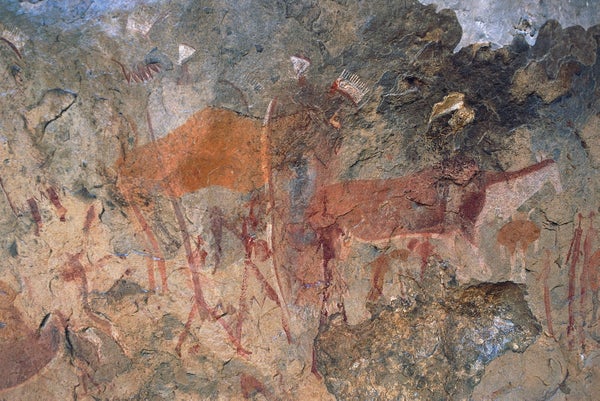Scientists have directly dated Stone Age rock paintings in southern Africa reliably for the first time. Their work reveals that early hunter-gatherer peoples created art at three sites in the region, some 5,700 years ago (A. Bonneau et al. Antiquity 91, 322–333; 2017). And the findings open the door for archaeologists and other researchers to date thousands more rock paintings in this part of Africa — and so piece together the lives and development of ancient people there.
The study focused on paintings in present-day Botswana, South Africa and Lesotho created by the San people, whose direct descendants still live in the area. The San have been much studied, but many mysteries remain about how they lived, and how they interacted with other groups — such as early farmers.
“If we are able to date depictions of livestock and material goods associated with incoming groups, we may be able to start unravelling the nature of interactions between groups in this early contact,” says David Pearce, an archaeologist and director of the Rock Art Institute at the University of the Witwatersrand in Johannesburg, South Africa, and a co-author of the latest study.
On supporting science journalism
If you're enjoying this article, consider supporting our award-winning journalism by subscribing. By purchasing a subscription you are helping to ensure the future of impactful stories about the discoveries and ideas shaping our world today.
Just under 2,000 years ago, Pearce says, pastoral and farming people independently arrived in South Africa, where they came into contact with hunter-gatherer groups such as the San. “We know relatively little about these groups because of the paucity of archaeology.” Rock paintings show that these groups interacted, but, because the paintings were discovered at sites that contain no other artefacts, they have not been reliably dated.
“What we’ve been doing previously existed out of time,” says Pearce. He adds that, although “we know a lot about what the paintings mean”, scientific techniques have not been widely applied to archaeological findings in the region. Many experts had assumed that the black paint used in African pictures was based on manganese compounds and that the rock art would therefore have contained too little carbon to be reliably dated, he says. As a result, techniques developed in Europe and elsewhere have not previously been applied in Africa.
Yet southern African rock art is highly influential. “It was ethnographies of San bushmen art that provided many of the models for social interpretation of the art we still use today,” says Alistair Pike, an archaeologist at the University of Southampton, UK, who was not involved in the research. And pictures left by the San and others could help researchers to put dates on other significant events, including the development of early religious rituals.
Dating rock pictures is itself a tricky art. Extracting useful samples damages paintings, and it is hard to distinguish original materials from modern contaminants. Over the years, compounds that contain carbon build up on top of the pictures and interfere with radiocarbon dating. And it’s not enough to know that a sample contains carbon: charcoal used in paint, for example, could pre-date a painting by centuries and so affect the result of the carbon tests.
Pigments of the imagination
“While doing the characterization of the different paints, we realized that the San people used three different materials to make black paints: charcoal, soot and carbon-blacks, which are burnt fat or grease,” says Adelphine Bonneau, a postdoctoral researcher at Laval University in Quebec, Canada, who is lead author on the study. Soot and carbon-blacks would have had to be produced a few hours before being used — and that meant they could be tested to give an accurate date.
It was this fact that formed the basis of her team’s multi-stage technique. First, Bonneau and her colleagues took tiny samples — less than one square millimetre — and determined their chemical composition. If they found testable carbon, the researchers took a larger sample. They cleaned away centuries of accumulated surface compounds such as calcium oxalate, which contaminate test results, and then carbon-dated the sample.
Georges Sauvet, an archaeologist with the Emile Cartailhac Prehistoric Art Research and Study Center at the University of Toulouse-Jean Jaurès in France, questioned the efficacy of the cleaning process, saying: “They seem to be reticent to show clearly that they have totally removed the calcium oxalate, and I don’t know why.”
Pike welcomed the technique and the results, but warned that it might not be suitable for older sites with more organic contaminants. “Were these paintings older, I would be more cautious in accepting these results,” he says. But young sites made from similar materials could be dated using this method.
“I hope that the team are able to continue to provide dates for paintings in Africa,” Pike adds. “The earliest forms of symbolic expression are known from Africa, so perhaps there are older paints in Africa that have yet to be found, or yet to be dated.”
This article is reproduced with permission and was first published on May 3, 2017.
